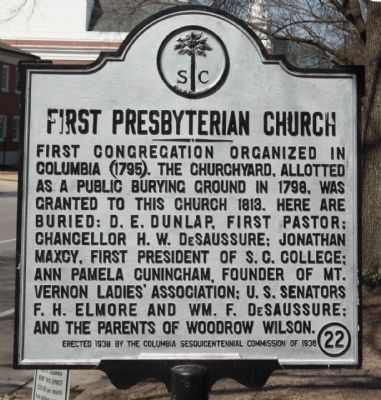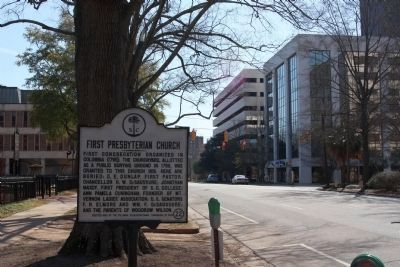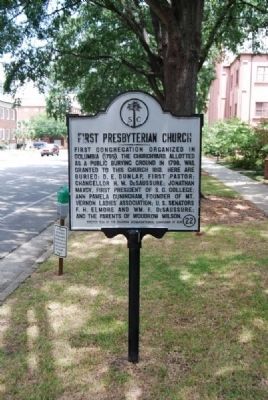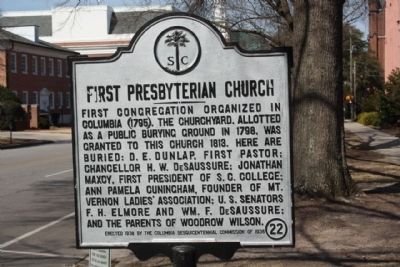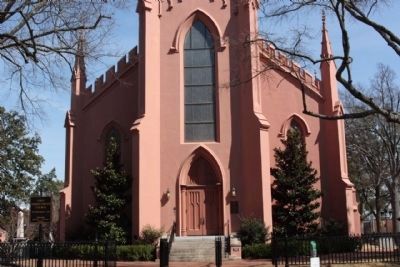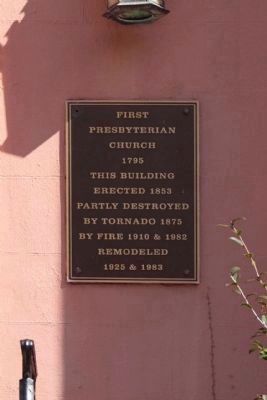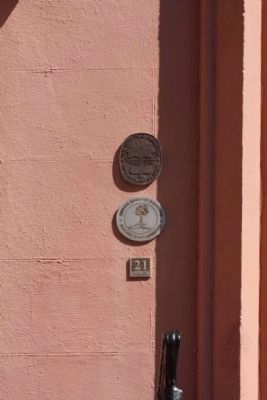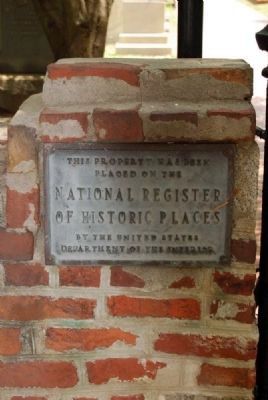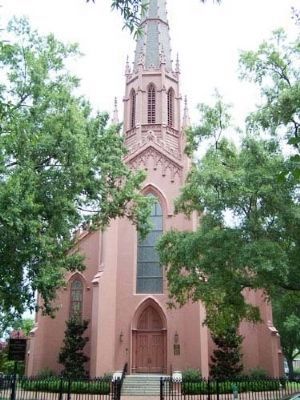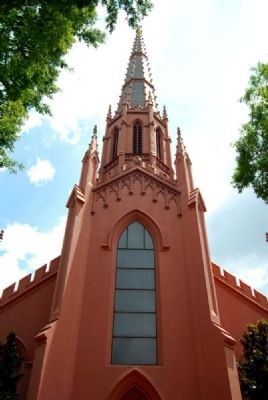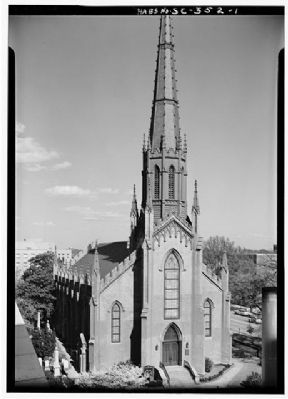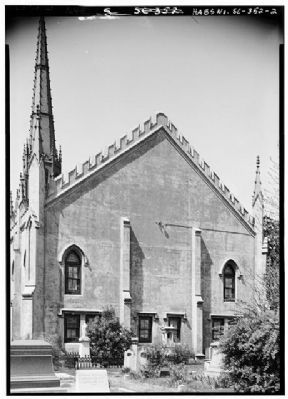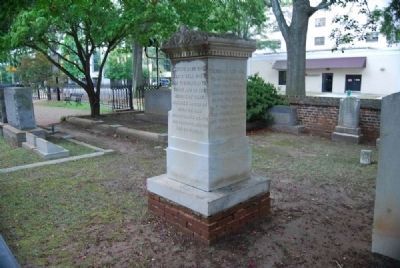Midtown - Downtown in Columbia in Richland County, South Carolina — The American South (South Atlantic)
First Presbyterian Church
First congregation organized in Columbia (1795). The churchyard, allotted as a public burying ground in 1798, was granted to this church 1813. Here are buried: D.E. Dunlap, first pastor; Chancellor H.W. DeSaussure; Jonathan Maxcy, first President of S.C. College; Ann Pamela Cuningham, founder of Mt. Vernon Ladies' Association; U.S. Senators F.H. Elmore and Wm. F. DeSaussure, and the parents of Woodrow Wilson.
Erected 1938 by The Columbia Sesquicentennial Commission of 1936. (Marker Number 40-22.)
Topics and series. This historical marker is listed in these topic lists: Cemeteries & Burial Sites • Churches & Religion. In addition, it is included in the Former U.S. Presidents: #28 Woodrow Wilson series list. A significant historical year for this entry is 1798.
Location. 34° 0.237′ N, 81° 1.862′ W. Marker is in Columbia, South Carolina, in Richland County. It is in Midtown - Downtown. Marker is on Marion Street north of Lady Street, on the right when traveling north. Touch for map. Marker is at or near this postal address: 1324 Marion Street, Columbia SC 29201, United States of America. Touch for directions.
Other nearby markers. At least 10 other markers are within walking distance of this marker. A different marker also named First Presbyterian Church (a few steps from this marker); Cecil Herbert Land D.D. (within shouting distance of this marker); First Presbyterian Church Confederate Veterans Monument (within shouting distance of this marker); Site of Columbia High School (about 400 feet away, measured in a direct line); Site of Columbia Female Academy (about 500 feet away); Washington Street Methodist Church (about 500 feet away); a different marker also named Washington Street Methodist Church (about 500 feet away); Marion Street (about 800 feet away); Wade Hampton (approx. 0.2 miles away); Bull Street (approx. 0.2 miles away). Touch for a list and map of all markers in Columbia.
Regarding First Presbyterian Church. The First Presbyterian Church, constructed ca. 1854, is a fine example of early English Gothic architecture, characterized by a vaulted ribbed ceiling. Its 188-foot spire is one of Columbia’s most distinctive architectural features. Its congregation was the first organized in Columbia (1795). According to tradition, the Presbyterian congregation drew lots with the Episcopal congregation, and won its present lot, which included the heretofore public non-denominational Columbia graveyard, dating from 1797. Buried here are Henry W. DeSaussure, first
director of the U.S. Mint, Ann Pamela Cuningham, restorer of Mt. Vernon and President Woodrow Wilson’s parents.
Past congregational members include Colonel Thomas Taylor (upon whose plantation part of Columbia was built), scientist Dr. Joseph LeConte, architect Robert Mills and President Woodrow Wilson. The English Gothic structure is of reddish-brown stucco-covered brick. It features a central pinnacled steeple, an entrance flanked by pseudo-Corinthian columns, shouldered buttresses, stained glass windows, and pinnacles on the corners and along the battlemented roof. It is the second church built on this site. The church building was extensively remodeled in 1925.
Listed in the National Register January 25, 1971.(South Carolina Department of Archives and History)
National Register of Historic Places:
First Presbyterian Church *** (added 1971 - - #71000801)
♦1324 Marion St. , Columbia
♦ Historic Significance: Architecture/Engineering
♦ Architect, builder, or engineer: Unknown
♦ Architectural Style: Gothic
♦ Area of Significance: Architecture
♦ Period of Significance: 1850-1874
♦ Owner: Private
♦ Historic Function: Funerary, Religion
♦ Historic Sub-function: Cemetery, Religious Structure
♦ Current Function: Funerary, Religion
♦ Current Sub-function: Cemetery, Religious Structure
Also see . . . First Presbyterian Church. The First Presbyterian Church, constructed ca. 1854, is a fine example of early English Gothic architecture, characterized by a vaulted ribbed ceiling. (Submitted on August 20, 2011, by Brian Scott of Anderson, South Carolina.)
Additional commentary.
1. First Presbyterian Church - National Register Nomination Form (1970)
Description
English Gothic structure of reddish-brown stucco-covered brick; second building erected on site. central pinnacled steeple with entrance below flanked by pseudo-Corinthian columns, shouldered buttresses, pinnacles also on corners and alongside of battlemented roof, stained glass windows.
First church on site built 1813 from materials of old Lexington County Courthouse at Granby. 1852-1853 this building moved to corner of Lady and Marion Streets. As built in 1854 new church was 58' x 78' and had 180-foot spire which was damaged by 1875 cyclone, rebuilt 1888, damaged by 1910 fire, rebuilt same year to present height of 188 feet.
Building was extensively remodeled in 1912 -- lengthened by 40 feet (three bays). New rostrum and choir behind which, facing congregation, is wood screen of Gothic tracery. Organ, brought from Grace Church in Charleston
after Civil War, rebuilt behind screen. Classrooms built on either side of organ loft; gallery around three sides of church. Central main entrance retained but altered to fit new height of vestibule floor by construction of granite steps. Flanking front entrances closed and new ones built into side vestibules near west corners of north and south walls. New seating capacity: 1,2500 (original capacity: 800).
Significance
Church is exceptionally fine example of early English Gothic architecture, characterized by a vaulted ribbed ceiling. Its 188-foot spire is one of Columbia’s most distinctive architectural features.
Its congregation was the first organized in Columbia (1795). After its founding, services were held in State House, then in the South Carolina College Chapel. Incorporated by 1813 South Carolina Legislature. According to tradition, the Presbyterian congregation drew lots with the Episcopal congregation, and won its present lot, which included the heretofore public non-denominational Columbia graveyard, dating from 1797. Buried here: Henry W. DeSaussure, first director of the U.S. Mint, Ann Pamela Cuningham, restorer of Mt. Vernon and President Woodrow Wilson’s parents.
Among church's famous members: scientist Dr. Joseph LeConte, Woodrow Wilson, Robert Mills (who was elder 1822-1830), and Col. Thomas Taylor (upon whose plantation part of Columbia was built)
Church has been closely associated with University of South Carolina (originally the South Carolina College). James Thornwell, professor and president of the college, was pastor 1840-1841, and 1855-1861. a number of other university presidents have served as elders or have been otherwise closely connected with the church.
The church has also had strong ties with Columbia Theological Seminary, located for many years in the historic Ainsley Hall House. Such noted Presbyterians as Drs. George Howe, B.M. Palmer, and J.L. Girardeau as well as Dr. Thornwell were on the facility of the seminary.
— Submitted August 21, 2011, by Brian Scott of Anderson, South Carolina.
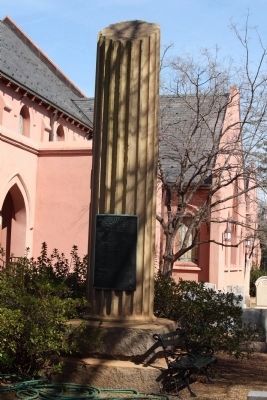
Photographed By Mike Stroud, February 21, 2010
10. First Presbyterian Church Cemetery
Confederate States Army
from the congregation of
The First Presbyterian Church
Columbia, South Carolina
1861-1865
Dedicated to those who died
in gratitude to those who served
(List of 64 names)
*****
Members of this Congregation after 1865, who served
in the Confederate Army
(List of 22 names)
Erected 1920
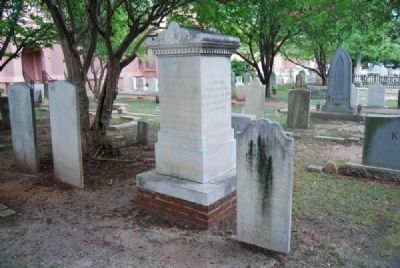
Photographed By Brian Scott, July 25, 2011
14. John Bryce Tombstone
to
the memory of
John Bryce,
who was born in
Glascow, Scotland,
May 11th 1768, and died
in this city, November
24th 1855 having
been resident here
more than 50 years.
"Precious in the sight of the Lord
is the death of His saints."
----------
Sacred to the memory of
Sarah F. Bryce
Wife of John Bryce
Born in Branby, Lexington Co, S.C.
Oct. 2, 1795
Died in Columbia S.C May 2, 1872
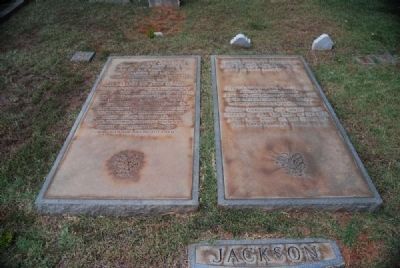
Photographed By Brian Scott, July 25, 2011
16. James Wyly & Alice Stewart Jackson Tombstone
[Left]:
James Wyly Jackson
July 10, 1893 Gate City, Va
Dec 13, 1968 Columbia, SC
Pastor of the
First Presbyterian Church
Columbia SC
Feb 4, 1931 to July 15, 1952
Called of God to minister to his people
in days of prosperity and days of distress.
His shared abundantly with children
the warmth of his hearts, with youth
his intelligence and understanding,
with the mature his wisdom and strength,
and with those in the evening of life
his comfort and confidence, and
how awaits the invitation: "Come, ye
blessed of my father -- enter
thou into the joy of thy Lord."
July 10, 1893 Gate City, Va
Dec 13, 1968 Columbia, SC
Pastor of the
First Presbyterian Church
Columbia SC
Feb 4, 1931 to July 15, 1952
Called of God to minister to his people
in days of prosperity and days of distress.
His shared abundantly with children
the warmth of his hearts, with youth
his intelligence and understanding,
with the mature his wisdom and strength,
and with those in the evening of life
his comfort and confidence, and
how awaits the invitation: "Come, ye
blessed of my father -- enter
thou into the joy of thy Lord."
Credits. This page was last revised on February 16, 2023. It was originally submitted on March 24, 2010, by Mike Stroud of Bluffton, South Carolina. This page has been viewed 1,368 times since then and 67 times this year. Photos: 1, 2. submitted on March 24, 2010, by Mike Stroud of Bluffton, South Carolina. 3. submitted on August 20, 2011, by Brian Scott of Anderson, South Carolina. 4, 5, 6, 7. submitted on March 24, 2010, by Mike Stroud of Bluffton, South Carolina. 8. submitted on August 20, 2011, by Brian Scott of Anderson, South Carolina. 9, 10. submitted on March 24, 2010, by Mike Stroud of Bluffton, South Carolina. 11. submitted on August 20, 2011, by Brian Scott of Anderson, South Carolina. 12, 13. submitted on May 19, 2010, by Mike Stroud of Bluffton, South Carolina. 14, 15. submitted on August 21, 2011, by Brian Scott of Anderson, South Carolina. 16. submitted on August 22, 2011, by Brian Scott of Anderson, South Carolina. • Bill Pfingsten was the editor who published this page.
